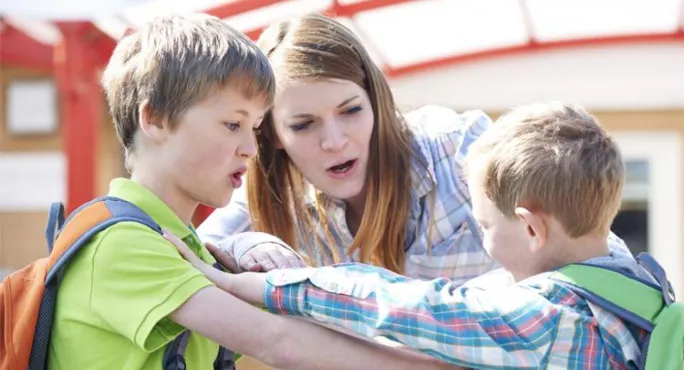
- Home
- Why are there no headlines when behaviour in school improves?
Why are there no headlines when behaviour in school improves?

It used to be that, each February, media outlets across Scotland would dust down the headlines for one of their few in-depth education stories. Headlines would read something like “Shocking increase in pupil exclusions”, “Pupil violence rising” or “Classroom bad behaviour on the up”.
Such headlines appeared after national exclusion statistics were published and they just about showed a year-on-year increase from their first publication in 2000 (42,340 exclusions) through to 2007 (44,794 exclusions). The publication of these statistics allowed commentators a front-page headline, a solemn editorial and at least three or four weeks of columns and letters to the editor each year. They were good copy.
Autism: ‘Dare to see the reasons behind behaviour’
A mother’s view: ‘Restraint isn’t happening to burly teens’
More on behaviour: Go to our hub for articles on behaviour
Sadly - at least from the point of view of editors, it seems - the figures that were reported each year began to show a decline from the high of 44,794, down to 30,211 in 2011 then 18,361 in 2017. Over a 10-year period, the decline was year on year - so no headlines here and little scope for a sensational take on pupil behaviour.
In 2015, the Organisation for Economic Cooperation and Development reported on other positive aspects of Scottish adolescents. In the report, it noted that the proportion of 15-year-olds who reported drinking alcohol on a weekly basis “dropped sharply, from 43 per cent in 2002 to 14 per cent in 2014”. Nearly a quarter of Scottish 15-year-olds were smokers in 2002 but this had dropped to 14 per cent in 2014, while more than two-thirds of Scottish teenagers thought that their school provided them with advice and support regarding smoking, alcohol consumption and drug use.
And there is other evidence about young people being satisfied with school - high levels of young people like what their schools offers them.
But it isn’t just in schools where the picture has been changing. Referrals to children’s hearings for offences across Scotland showed an even greater decrease, from a peak of 17,361 in 2005-06, to a low of 2,761 in 2015-16. In anyone’s view of statistics, it’s a remarkable decline in misbehaviour, perhaps worth highlighting, if not celebrating.
Serious criminal offending is in decline, too: as a result, one of the secure units that used to hold under-16s has had to be closed and converted into a school. Our young offenders institution at Polmont has also seen a decline in 16- to 18-year-olds placed there. As a comparison, there has been no significant decline in adult criminality - yet.
None of this is to deny that we have some violent young people on our streets or in our schools. There is no minimising the impact of crime or abusive behaviour, wherever it arises.
However, even in the educational media, the broad narrative of behaviour among our teenagers in 21st century Scotland has not been about the declining incidents of poor behaviour, never mind seeking out stories and explanations for such decreases.
Why is it that behaviour is improving? Why is it that teachers’ main concerns are about low-level indiscipline? Why are fewer children facing exclusion? Why are they offending less in their community? Finding answers to these questions would be a more profitable use of commentators’ time.
It may well be, in part, that online gaming has taken over children’s lives, causing them to be behaving badly in online communities rather than on our streets. However, I tend to look for policy answers. First, Scotland took indiscipline seriously from 2000 onwards and invested money in dealing with poor behaviour in classrooms and schools.
Other elements that have affected the statistics could be changes in Curriculum for Excellence, particularly in primary schools, which promoted more active and relevant activities in classroom that could hold boys’ interests. In secondary schools, too, personalised approaches drawing on resources outside the school and in communities, gave some young people a greater sense of worth rather than feeling discarded by the end of S2, as has often been the case.
The more recent developments of trauma-informed practice and an awareness of adverse children’s experiences are again useful in understanding behaviour as “stressed” behaviour rather than “bad”. You may have your own supporting analysis.
But whatever the factors behind it, our national story of better-behaved children doesn’t seem to sell newspapers or entice enough clickbait. Surely it is worth commentating on, reporting about, highlighting and celebrating?
David Watt is an education blogger and former schools inspector. Until recently, he was Education Scotland’s senior education officer for inclusion and equalities, and he has also represented Scotland on the European Agency for Special Needs and Inclusive Education. He tweets @dknwatt
Register with Tes and you can read five free articles every month, plus you'll have access to our range of award-winning newsletters.
Keep reading for just £4.90 per month
You've reached your limit of free articles this month. Subscribe for £4.90 per month for three months and get:
- Unlimited access to all Tes magazine content
- Exclusive subscriber-only stories
- Award-winning email newsletters
You've reached your limit of free articles this month. Subscribe for £4.90 per month for three months and get:
- Unlimited access to all Tes magazine content
- Exclusive subscriber-only stories
- Award-winning email newsletters